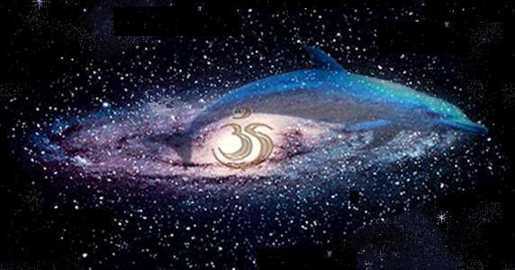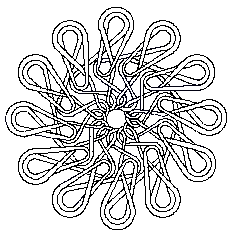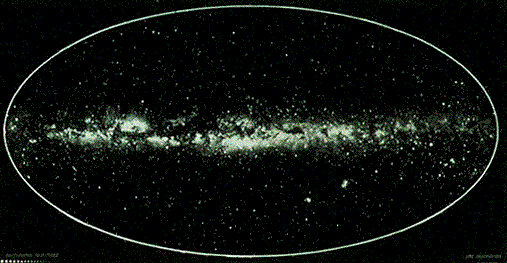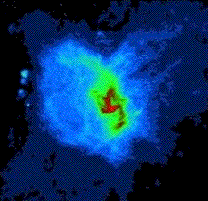

This
panoramic view of the center of our Milky
Way Galaxy is at a radio
wavelength (color) of approximately 1 meter
 What
is Galactic Time? What
is Galactic Time?
 Why
Galactic time? Why
Galactic time?
 How
Galactic time? How
Galactic time?
 Links Links
 Wiki-page Wiki-page
|
How Galactic Time?
  When
Julius
Caesar
introduced
the new calendar in 45
B.C.
the old lunar calendar was abolished. On itself the
calendar was conceived beautifully transposing the
division of the lunar calendar to the solar year. But
actually the roman empire dropped out of the
consciousness of the moonrhythm and thus lost touch with
its roots of conditioning. Instead of an expansion to the
complete of the reality of time adding the respect for
the sun to the already existing moon-culture,
it
became a repression
of the moonrhytm by the sunrhythm. Both rhythms are
correct in themselves, but the natural consciousness of
knowing the difference between the old conditioning of
the moon and the new one to the sun, was not
achieved. When
Julius
Caesar
introduced
the new calendar in 45
B.C.
the old lunar calendar was abolished. On itself the
calendar was conceived beautifully transposing the
division of the lunar calendar to the solar year. But
actually the roman empire dropped out of the
consciousness of the moonrhythm and thus lost touch with
its roots of conditioning. Instead of an expansion to the
complete of the reality of time adding the respect for
the sun to the already existing moon-culture,
it
became a repression
of the moonrhytm by the sunrhythm. Both rhythms are
correct in themselves, but the natural consciousness of
knowing the difference between the old conditioning of
the moon and the new one to the sun, was not
achieved.
In
425 A.D. the roman empire
fell
after centuries of corrupt emperors like Nero and
Caligula, overtaken by the barbarian forces who
managed... a mooncalender. At that time at the onset of
the christian era the julian rhythm of
the
solar weekorder was
repressed
with the commercial/religious order of the present
weekorder, which introduced linear time estranged from
the natural dynamics of time one formerly respected. This
linear time later culminated in our present standard time
of linear management and is purely political of nature in
its implementation.


 In
the eight century
Islam
came about countering the then troublesome progressing
christian culture which had lost touch with the classical
roman and greek culture. Plato was abolished as heretic
and many old sciences were forgotten. The roman sundial
(the cupped one of the Babylonian Berosos from 500 B.C..
) was abolished and replaced with the ancient flat one
giving regular hours but with with one lost sight of the
times of sunset and sunrise. Islam adhered to a purely
lunar calendar and prayertimes to the position of the sun
and tried to conquer Europe. They defeated Byzantium, but
never succeeded to impose the culture of their respect
for the natural order on the Europeans.
Again
repression
of one system by the other turned out to be
unsuccessful. In
the eight century
Islam
came about countering the then troublesome progressing
christian culture which had lost touch with the classical
roman and greek culture. Plato was abolished as heretic
and many old sciences were forgotten. The roman sundial
(the cupped one of the Babylonian Berosos from 500 B.C..
) was abolished and replaced with the ancient flat one
giving regular hours but with with one lost sight of the
times of sunset and sunrise. Islam adhered to a purely
lunar calendar and prayertimes to the position of the sun
and tried to conquer Europe. They defeated Byzantium, but
never succeeded to impose the culture of their respect
for the natural order on the Europeans.
Again
repression
of one system by the other turned out to be
unsuccessful.


 At
the end of the Middle Ages the concept of
time
mechanized with
the rise of popular mechanical clocks that after a few
centuries started to contest the natural order making
mean time, zonetime and summertime, thus separating the
concept of time from the concept of space. Breaking the
classical alliance of the two, mankind lost thus sight of
cyclic time and the natural oneness of time and
place
(although
by Einsteins physics we achieved to a scientific respect
for the relative of time and place.) In the twentiest
century
the repression
of the cyclic time of respecting the heavenly bodies by
the linear concept of mechanical electromagnetic atomic
time resulted in a total self-alienation of mankind as
evidenced by two gruesome worldwars in which Christianity
had to pay for its offenses against the natural balance
of time and space. Soldiers of Hitler Germany died in
Stalingrad with the time of Berlin still on their
watches. (there are more possible causes to these wars of
course). For
the third time mankind had to pay heavily for its
repression of the old by the new. At
the end of the Middle Ages the concept of
time
mechanized with
the rise of popular mechanical clocks that after a few
centuries started to contest the natural order making
mean time, zonetime and summertime, thus separating the
concept of time from the concept of space. Breaking the
classical alliance of the two, mankind lost thus sight of
cyclic time and the natural oneness of time and
place
(although
by Einsteins physics we achieved to a scientific respect
for the relative of time and place.) In the twentiest
century
the repression
of the cyclic time of respecting the heavenly bodies by
the linear concept of mechanical electromagnetic atomic
time resulted in a total self-alienation of mankind as
evidenced by two gruesome worldwars in which Christianity
had to pay for its offenses against the natural balance
of time and space. Soldiers of Hitler Germany died in
Stalingrad with the time of Berlin still on their
watches. (there are more possible causes to these wars of
course). For
the third time mankind had to pay heavily for its
repression of the old by the new.

 Now,
since the second half of the twentiest century we have
entered the digital age accompanied by an enormous influx
of foreign culture that brought back the mooncalendar and
the respect for the natural cycles of time in the form of
a complement to our onesided timeculture. The
hindu-scripture the Srimad
Bhagavatam
talking
about meditating the Virat Rupa, the Universal Form of
God states:
Now,
since the second half of the twentiest century we have
entered the digital age accompanied by an enormous influx
of foreign culture that brought back the mooncalendar and
the respect for the natural cycles of time in the form of
a complement to our onesided timeculture. The
hindu-scripture the Srimad
Bhagavatam
talking
about meditating the Virat Rupa, the Universal Form of
God states:

The
Galaxy, the unity of God
represented as a dolphin, a
sisumâra
"
In
the control of the divinity of fire one reaches,
following the movements in the sky, through the
gracious passage of breath
[the
Susumna],
the pure spirit [Brahmaloka,
place of the Creator]
that is illuminating and washing off the
contaminations, after which one reaching upward
attains to the circle
[the
cakra, the wheel],
o king, called Sisumara
[meaning:
dolphin, to the form of the Milky Way, galactic
time]."
(S.B..
2-2-24 and
5.23)
From
the multifaith
culture
we cannot escape anymore from a diversity of
timeconcepts. The cultures all together command an
integrative approach
forbidding repression and
downfall again. The mission with this digital culture in
the twenty-first century is to arrive at a full concept
of order that is in respect with as well the sun, the
moon as with the celestial sky. The respect for cyclic
time needs to be restored in making
for a worldorder that is capable of doing justice to each
individual timeculture on this
planet.

A
graphic representation of the intertwined 12-division
of the culture of astronomy, the solar political
calendar
and the religious mooncalender with their zodiacal
signs,
solar and lunar months.(from
Filognosy:
filognostic art).
This
means that we need the Gregorian
calendar for
respecting the sun. It means that we need
the
mooncalendar
of the Chinese, Indians and Muslims to respect the Moon.
It means that we have to settle
a day to manage a collective persistent respect for the
dynamic celestial sky
making for the precession of the equinox and the center
of the Galaxy. A galactic 'new year' that shifts every
70,638 years with one day ahead through our known sun and
moon calendar.(see
full
calendar of Order)

how
the galaxy actually looks like in the
telescope
The day
settled for respecting the event of being closest to the
center of the galaxy is timed at
midnight
UTC of the the year 2000 from the sixth to the seventh of
July.
(eventually there can be an astronomical correction to
this timing as it is a first estimate from a formerly not
existing culture of galactic timerespect).

VLAimage
of the galactic center showing a three armed minispiral
of hot gas.
Sagittarius
A, the 'navel of Vishnu ' is at the exact center of the
spiral.
The
teacher of physics Mr. Richard Goode from Porterville
High School writes (for the Site Mad
Scientist),
emailing about the matter of timing the shift of the
calendar to the galactic center necessitating a shift of
respect for the galactic 'day' (that runs forward trough
the calendar):
"I
would insert 1 day into the rotation each 71 years and
skip the additional day each 8 rotations. Doing it
this way you would still drift over the 25800 years
very slowly. You could also add 1 hour each 3
years."

The
dolphin is apart from the vedic name for the
galaxy
also
a constellation of the greek culture with Erastostenes
Thus
galactic time can be respected. The symbol is
a
dolphin,
the name is Cakra.
We wish you a happy galactic new year from the 6/7 of
July 2000 on into the years thereafter .
previous|galactic
time-main|next

© The
Order of Time
|



![]()

![]() How
Galactic time?
How
Galactic time?![]()
 When
Julius
Caesar
introduced
the new calendar in 45
B.C.
the old lunar calendar was abolished. On itself the
calendar was conceived beautifully transposing the
division of the lunar calendar to the solar year. But
actually the roman empire dropped out of the
consciousness of the moonrhythm and thus lost touch with
its roots of conditioning. Instead of an expansion to the
complete of the reality of time adding the respect for
the sun to the already existing moon-culture,
it
became a repression
of the moonrhytm by the sunrhythm. Both rhythms are
correct in themselves, but the natural consciousness of
knowing the difference between the old conditioning of
the moon and the new one to the sun, was not
achieved.
When
Julius
Caesar
introduced
the new calendar in 45
B.C.
the old lunar calendar was abolished. On itself the
calendar was conceived beautifully transposing the
division of the lunar calendar to the solar year. But
actually the roman empire dropped out of the
consciousness of the moonrhythm and thus lost touch with
its roots of conditioning. Instead of an expansion to the
complete of the reality of time adding the respect for
the sun to the already existing moon-culture,
it
became a repression
of the moonrhytm by the sunrhythm. Both rhythms are
correct in themselves, but the natural consciousness of
knowing the difference between the old conditioning of
the moon and the new one to the sun, was not
achieved.![]()
![]()
 In
the eight century
Islam
came about countering the then troublesome progressing
christian culture which had lost touch with the classical
roman and greek culture. Plato was abolished as heretic
and many old sciences were forgotten. The roman sundial
(the cupped one of the Babylonian Berosos from 500 B.C..
) was abolished and replaced with the ancient flat one
giving regular hours but with with one lost sight of the
times of sunset and sunrise. Islam adhered to a purely
lunar calendar and prayertimes to the position of the sun
and tried to conquer Europe. They defeated Byzantium, but
never succeeded to impose the culture of their respect
for the natural order on the Europeans.
Again
repression
of one system by the other turned out to be
unsuccessful.
In
the eight century
Islam
came about countering the then troublesome progressing
christian culture which had lost touch with the classical
roman and greek culture. Plato was abolished as heretic
and many old sciences were forgotten. The roman sundial
(the cupped one of the Babylonian Berosos from 500 B.C..
) was abolished and replaced with the ancient flat one
giving regular hours but with with one lost sight of the
times of sunset and sunrise. Islam adhered to a purely
lunar calendar and prayertimes to the position of the sun
and tried to conquer Europe. They defeated Byzantium, but
never succeeded to impose the culture of their respect
for the natural order on the Europeans.
Again
repression
of one system by the other turned out to be
unsuccessful.![]()
![]()
 At
the end of the Middle Ages the concept of
time
mechanized with
the rise of popular mechanical clocks that after a few
centuries started to contest the natural order making
mean time, zonetime and summertime, thus separating the
concept of time from the concept of space. Breaking the
classical alliance of the two, mankind lost thus sight of
cyclic time and the natural oneness of time and
place
(although
by Einsteins physics we achieved to a scientific respect
for the relative of time and place.) In the twentiest
century
the repression
of the cyclic time of respecting the heavenly bodies by
the linear concept of mechanical electromagnetic atomic
time resulted in a total self-alienation of mankind as
evidenced by two gruesome worldwars in which Christianity
had to pay for its offenses against the natural balance
of time and space. Soldiers of Hitler Germany died in
Stalingrad with the time of Berlin still on their
watches. (there are more possible causes to these wars of
course). For
the third time mankind had to pay heavily for its
repression of the old by the new.
At
the end of the Middle Ages the concept of
time
mechanized with
the rise of popular mechanical clocks that after a few
centuries started to contest the natural order making
mean time, zonetime and summertime, thus separating the
concept of time from the concept of space. Breaking the
classical alliance of the two, mankind lost thus sight of
cyclic time and the natural oneness of time and
place
(although
by Einsteins physics we achieved to a scientific respect
for the relative of time and place.) In the twentiest
century
the repression
of the cyclic time of respecting the heavenly bodies by
the linear concept of mechanical electromagnetic atomic
time resulted in a total self-alienation of mankind as
evidenced by two gruesome worldwars in which Christianity
had to pay for its offenses against the natural balance
of time and space. Soldiers of Hitler Germany died in
Stalingrad with the time of Berlin still on their
watches. (there are more possible causes to these wars of
course). For
the third time mankind had to pay heavily for its
repression of the old by the new.![]()
![]() Now,
since the second half of the twentiest century we have
entered the digital age accompanied by an enormous influx
of foreign culture that brought back the mooncalendar and
the respect for the natural cycles of time in the form of
a complement to our onesided timeculture. The
hindu-scripture the Srimad
Bhagavatam
talking
about meditating the Virat Rupa, the Universal Form of
God states:
Now,
since the second half of the twentiest century we have
entered the digital age accompanied by an enormous influx
of foreign culture that brought back the mooncalendar and
the respect for the natural cycles of time in the form of
a complement to our onesided timeculture. The
hindu-scripture the Srimad
Bhagavatam
talking
about meditating the Virat Rupa, the Universal Form of
God states:




![]()